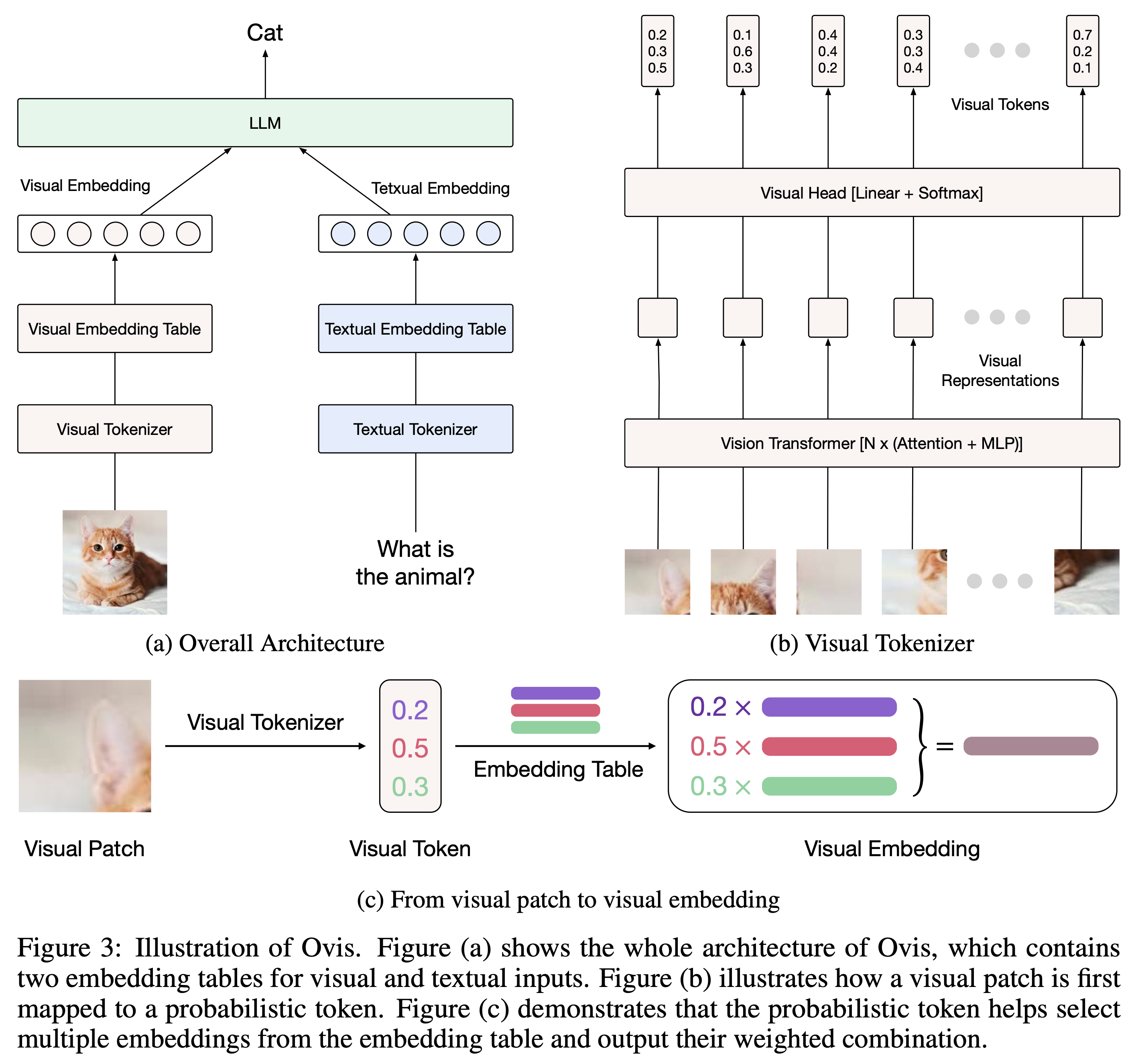---
license: apache-2.0
datasets:
- AIDC-AI/Ovis-dataset
library_name: transformers
tags:
- MLLM
pipeline_tag: image-text-to-text
---
## Introduction
Ovis is a novel Multimodal Large Language Model (MLLM) architecture, designed to structurally align visual and textual embeddings. For a comprehensive introduction, please refer to [Ovis paper](https://arxiv.org/abs/2405.20797) and [Ovis GitHub](https://github.com/AIDC-AI/Ovis).

## Model
As always, Ovis1.5 remains fully open-source: we release the training datasets, training & inference codes, and model weights for **reproducible transparency** and community collaboration.
| Ovis MLLMs | ViT | LLM | Training Datasets | Code | Model Weights |
|:-------------------------|:-----------:|:------------------:|:-------------------------------------------------------------------:|:-------------------------------------------:|:----------------------------------------------------------------:|
| Ovis1.5-Llama3-8B | Siglip-400M | Llama3-8B-Instruct | [Huggingface](https://huggingface.co/datasets/AIDC-AI/Ovis-dataset) | [Github](https://github.com/AIDC-AI/Ovis) | [Huggingface](https://huggingface.co/AIDC-AI/Ovis1.5-Llama3-8B) |
| Ovis1.5-Gemma2-9B | Siglip-400M | Gemma2-9B-It | [Huggingface](https://huggingface.co/datasets/AIDC-AI/Ovis-dataset) | [Github](https://github.com/AIDC-AI/Ovis) | [Huggingface](https://huggingface.co/AIDC-AI/Ovis1.5-Gemma2-9B) |
## Performance
We evaluate Ovis1.5 across various multimodal benchmarks using [VLMEvalKit](https://github.com/open-compass/VLMEvalKit) and compare its performance to leading MLLMs with similar parameter scales.
| | MiniCPM-Llama3-V2.5 | GLM-4V-9B | Ovis1.5-Llama3-8B | Ovis1.5-Gemma2-9B |
|:------------------|--------------------:|----------:|------------------:|------------------:|
| Open Weights | ✅ | ✅ | ✅ | ✅ |
| Open Datasets | ❌ | ❌ | ✅ | ✅ |
| MMTBench-VAL | 57.6 | 48.8 | 60.7 | **62.7** |
| MMBench-EN-V1.1 | 74 | 68.7 | **78.2** | 78.0 |
| MMBench-CN-V1.1 | 70.1 | 67.1 | **75.2** | 75.1 |
| MMStar | 51.8 | 54.8 | 57.2 | **58.7** |
| MMMU-Val | 45.8 | 46.9 | 48.6 | **49.8** |
| MathVista-Mini | 54.3 | 51.1 | 62.4 | **65.7** |
| HallusionBenchAvg | 42.4 | 45 | 44.5 | **48.0** |
| AI2D | 78.4 | 71.2 | 82.5 | **84.7** |
| OCRBench | 725 | **776** | 743 | 756 |
| MMVet | 52.8 | **58** | 52.2 | 56.5 |
| RealWorldQA | 63.5 | 66 | 64.6 | **66.9** |
| CharXiv Reasoning | 24.9 | - | 28.2 | **28.4** |
| CharXiv Descriptive | 59.3 | - | 60.2 | **62.6** |
## Usage
Below is a code snippet to run Ovis with multimodal inputs. For additional usage instructions, including inference wrapper and Gradio UI, please refer to [Ovis GitHub](https://github.com/AIDC-AI/Ovis?tab=readme-ov-file#inference).
```bash
pip install torch==2.1.2 transformers==4.43.2 pillow==10.3.0
```
```python
import torch
from PIL import Image
from transformers import AutoModelForCausalLM
# load model
model = AutoModelForCausalLM.from_pretrained("AIDC-AI/Ovis1.5-Gemma2-9B",
torch_dtype=torch.bfloat16,
multimodal_max_length=8192,
trust_remote_code=True).cuda()
text_tokenizer = model.get_text_tokenizer()
visual_tokenizer = model.get_visual_tokenizer()
conversation_formatter = model.get_conversation_formatter()
# enter image path and prompt
image_path = input("Enter image path: ")
image = Image.open(image_path)
text = input("Enter prompt: ")
query = f'\n{text}'
prompt, input_ids = conversation_formatter.format_query(query)
input_ids = torch.unsqueeze(input_ids, dim=0).to(device=model.device)
attention_mask = torch.ne(input_ids, text_tokenizer.pad_token_id).to(device=model.device)
pixel_values = [visual_tokenizer.preprocess_image(image).to(
dtype=visual_tokenizer.dtype, device=visual_tokenizer.device)]
# generate output
with torch.inference_mode():
gen_kwargs = dict(
max_new_tokens=1024,
do_sample=False,
top_p=None,
top_k=None,
temperature=None,
repetition_penalty=None,
eos_token_id=model.generation_config.eos_token_id,
pad_token_id=text_tokenizer.pad_token_id,
use_cache=True
)
output_ids = model.generate(input_ids, pixel_values=pixel_values, attention_mask=attention_mask, **gen_kwargs)[0]
output = text_tokenizer.decode(output_ids, skip_special_tokens=True)
print(f'Output: {output}')
```
## Citation
If you find Ovis useful, please cite the paper
```
@article{lu2024ovis,
title={Ovis: Structural Embedding Alignment for Multimodal Large Language Model},
author={Shiyin Lu and Yang Li and Qing-Guo Chen and Zhao Xu and Weihua Luo and Kaifu Zhang and Han-Jia Ye},
year={2024},
journal={arXiv:2405.20797}
}
```
## License
The project is licensed under the Apache 2.0 License and is restricted to uses that comply with the license agreements of Qwen, Llama3, Clip, and Siglip.
